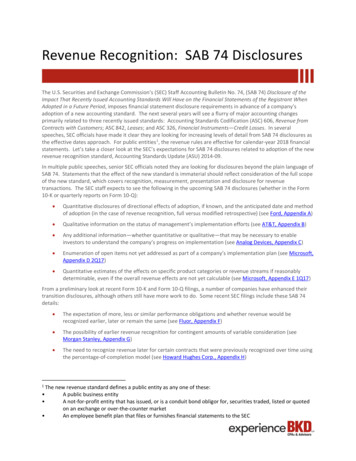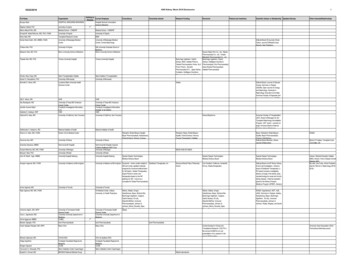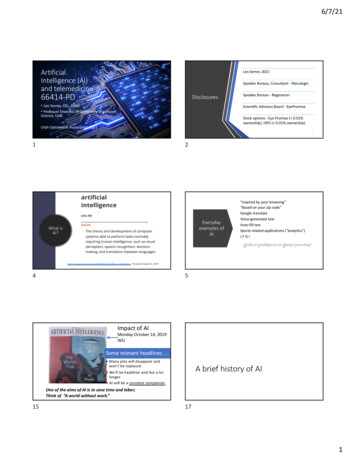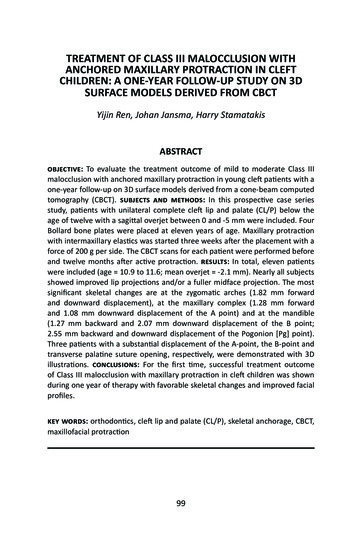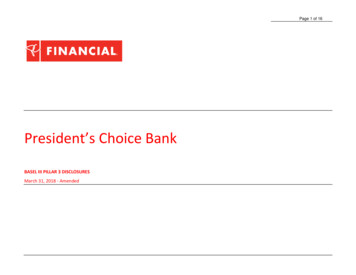
Transcription
Basel III Pillar 3 Disclosures – President’s Choice BankPresident’s Choice BankBASEL III PILLAR 3 DISCLOSURESMarch 31, 2018 - AmendedPage 1 of 16
Basel III Pillar 3 Disclosures – President’s Choice BankPage 2 of 16Table of ContentsTable of Contents . 2TABLE 1 – OVERVIEW & SCOPE OF APPLICATION . 3TABLE 2/3 – CAPITAL STRUCTURE AND ADEQUACY . 6TABLE 4 – CREDIT RISK: GENERAL DISCLOSURES FOR ALL BANKS . 8TABLE 5 – CREDIT RISK: DISCLOSURES FOR PORTFOLIOS SUBJECT TO THE STANDARDIZED APPROACH . 12TABLE 6 – CREDIT RISK: DISCLOSURES FOR PORTFOLIOS SUBJECT TO IRB APPROACHES . 12TABLE 7 – CREDIT RISK MITIGATION . 12TABLE 8 – GENERAL DISCLOSURE FOR EXPOSURES RELATED TO COUNTERPARTY CREDIT RISK . 12TABLE 9 – SECURITIZATION: DISCLOSURE FOR STANDARDISED APPROACH . 13TABLE 10 /11 – MARKET RISK . 14TABLE 12 – OPERATIONAL RISK . 14TABLE 13 – EQUITIES: DISCLOSURES FOR BANKING BOOK POSITIONS . 15TABLE 14 – INTEREST RATE RISK . 15LIQUIDITY RISK . 16CURRENCY RISK . 16
Basel III Pillar 3 Disclosures – President’s Choice BankPage 3 of 16TABLE 1 – OVERVIEW & SCOPE OF APPLICATIONThis document represents the Basel III Pillar 3 disclosures for President’s Choice Bank (“PC Bank” or the “the Bank”). These disclosures are made pursuant to OSFI’s Pillar3 Disclosure Requirements issued in November 2007, and OSFI’s Basel III Pillar 3 requirements Advisory issued in July 2013. Basel III, issued in June 2011, is part of theBasel Committee's continuous effort to enhance the banking regulatory framework. It builds on the International Convergence of Capital Measurement and CapitalStandards document (Basel II). Basel III is structured around 3 pillars: Pillar 1: Minimum Capital RequirementsPillar 2: The Supervisory Review ProcessPillar 3: Market DisciplinePillar 3 complements both Pillars 1 and 2, by setting disclosure requirements which will allow market participants to assess key pieces of information on the scope ofapplication, capital, risk exposures, risk assessment processes, and hence the capital adequacy of PC Bank.OSFI requires all institutions to implement the Basel III framework, and the new composition of capital disclosure requirements. This document presents capital structureand adequacy calculations based on Basel III guidelines on an “All-in” basis as per OSFI requirement.This report is unaudited and is reported in thousands of Canadian dollars, unless otherwise disclosed.The report is available on-line at cial-reporting/default.aspx and n/legal.President’s Choice Bank OverviewPC Bank is a Schedule I Canadian chartered bank governed by the Bank Act (Canada) and is a wholly owned subsidiary of Loblaw Companies Limited (“LCL”). In associationwith other financial institutions, PC Bank offers, under the President’s Choice Financial brand, a complete line of retail financial services products to individuals whoreside in Canada. On August 16, 2017, PC Bank entered into a mutual agreement to end its core banking relationship with another financial institution effective from Q22018. The key business lines of PC Bank are as follows:Credit CardPC Bank launched its credit card program in 2001 and currently offers the President’s Choice Financial MasterCard (“PC MasterCard”) across Canada. The PC MasterCardproduct attributes include no annual fee and a competitive rewards program which allows customers to earn and redeem PC Points for free groceries at LCL stores. PCBank records the credit card receivables and associated funding on its balance sheet.
Basel III Pillar 3 Disclosures – President’s Choice BankPage 4 of 16Core BankingPC Bank launched its core banking business in 1998 through a strategic partnership with a major Canadian Chartered Bank (“Strategic Partner”). Under the President’sChoice Financial brand, retail banking products are sold online and in LCL stores at banking pavilions operated by the Strategic Partner. All deposits, investments andlending products issued under the PC Financial brand are recorded by the Strategic Partner on its balance sheet. PC Bank earns income through this partnership. In thethird quarter of 2017, PC Bank entered into a mutual agreement to end its relationship with the Strategic Partner effective Q2 2018.GIC’sPC Bank launched a broker originated GIC program in 2010. The GIC’s offered by PC Bank are insured by Canadian Deposit Insurance Corporation (“CDIC”). PC Bank issuesnominee name GIC’s through a number of brokers in Canada.Corporate GovernanceThe Bank maintains a rigorous corporate governance structure as follows: Board of Director’s Oversightoooo Risk CommitteeAudit CommitteeConduct Review CommitteeGovernance CommitteeSenior Management Oversight through the following:oEnterprise Risk Management Committee (“ERMC”) – provides stewardship over the identification, definition, assessment, management, control,measurement, monitoring and reporting of PC Bank’s enterprise risks. Asset Liability Committee (“ALCO”) – assists the Risk Committee of the Board in Overseeing PC Bank’s risk management activities by providing strategic direction on the management of liquidity risk, interest raterisk, investment risk, and other aspects of Asset Liability Management; Ensuring that PC Bank has the appropriate quantity and quality of capital, considering its strategic direction & business plans, its riskprofile, its emerging risks and stress tests; and Proactively assessing the balance sheet dynamics, having regard to economic data and forecasts, PC Bank’s legal structure, marketdevelopments, accounting pronouncements, etc. Credit Risk and Fraud Management Committee (“CRFMC”) – has the following key responsibilities: Providing a governance structure that oversees the Credit Risk Management program, including the associated strategies, policies andprocedures;
Basel III Pillar 3 Disclosures – President’s Choice Bank o Page 5 of 16Ensuring that Credit Risk and Fraud Risk forecasts are appropriate giving consideration to PC Bank’s strategic directions, risk profileand appetite, emerging risks and stress tests; Providing guidance on the methodology to continually identify, define, assess, manage, and report Credit Risk and Fraud Risk exposure. Operational Risk Management Committee (“ORMC”) – is responsible for planning, directing, monitoring and controlling the impact of PCBank’s risks arising from its operations. Its key responsibilities include: Ensuring PC Bank’s compliance with operational mandates, policies and procedures, and governing legislation; Overseeing risk appetite, business continuity management, information security, internal control, outsourcing, social media, legal andregulatory risks management; Overseeing the anti-money laundering and anti-terrorist program; Overseeing other operational risks.Internal Audit (“IAS”) – assists Management in accomplishing its objectives by bringing a systematic, objective and disciplined approach to evaluate andimprove the effectiveness of PC Bank’s risk management, control and governance processes.The corporate governance structure diagram
Basel III Pillar 3 Disclosures – President’s Choice BankPage 6 of 16TABLE 2/3 – CAPITAL STRUCTURE AND ADEQUACYQUALITATIVE DISCLOSURESPC Bank Risk ManagementPC Bank calculates its regulatory capital based on the following methodologies: PC Bank manages its credit risk using the standardized approach PC Bank does not maintain a trading portfolio, and has minimal market risk from its high quality liquid asset portfolio; and PC Bank’s operational risk is monitored using the Basic Indicator Approach.PC Bank has implemented a comprehensive Internal Capital Adequacy Assessment Process (“ICAAP”) to identify and assess the material risks that PC Bank faces to ensurethat sufficient quality and quantity of capital is available. PC Bank is confident that the Pillar I and Pillar II calculations are appropriate given the PC Bank’s business model,inherent risks, internal controls and tools to manage risks and residual risks. The results of the ICAAP performed by PC Bank conclude that the Bank is strongly capitalized.The guiding principles of ICAAP are summarized below: Proportionality: The design of the Bank’s ICAAP is proportionate to the risk level, complexity and scale of PC Bank’s activities. Forward Looking: In the process of ICAAP, PC Bank considers not only the existing risks faced but also the emerging risks and future business strategies. Ongoing exercise: PC Bank’s ICAAP is not a static one-time process but rather a dynamic and continuous exercise to ensure that the PC Bank has robust riskmanagement systems and possesses sufficient capital at all times for risks. Evolving-nature: ICAAP is continuously monitored for improvement in accordance with changes to the risk profile and business plans of PC Bank. Use test: The methodology and risk limit structures used to measure and compute risk under ICAAP is integrated within the day to day risk practices of PC Bankthrough the ERM risk monitoring program. Specific limits and tolerances are monitored for capital & capital ratios on a monthly basis by the ERMC to ensure thatPC Bank stays within its risk appetite for all capital risks including those relating to ICAAP.Gross Common Equity Tier I CapitalThe capital structure of PC Bank consists of the following which combine to form PC Bank’s Gross Common Equity Tier I Capital: Common Shares; Retained Earnings; Contributed Surplus; and Accumulated Other Comprehensive Income (“AOCI”)The Bank is a wholly owned subsidiary of Loblaw Companies Limited. The Bank has authorized an unlimited number of common shares without par value. As at March31, 2018, PC Bank had 42,002 common shares issued and outstanding.
Basel III Pillar 3 Disclosures – President’s Choice BankPage 7 of 16QUANTITATIVE DISCLOSURES (AMENDED)March 31, 2018Total Capital1Directly issued qualifying common share capital plus related stock surplus2Retained Earnings3Accumulated other comprehensive income (and other reserves)6Common Equity Tier 1 capital before regulatory adjustments28Total regulatory adjustments to Common Equity Tier 129Common Equity Tier 1 Capital (CET1)44Additional Tier 1 capital (AT1)45Tier 1 capital (T1 CET1 AT1)58Tier 2 capital (T2)59Total Capital (TC T1 25,640842,774Risk Weighted Assets Calculation (Standard Approach)60Total Risk Weighted AssetsCapital Ratio61Common Equity Tier 1 (as % of risk-weighted assets)62Tier 1 (as % of risk-weighted assets)63Total Capital (as % of risk-weighted assets)3,550,02423.02%23.02%23.74%OSFI All-in Target697071Common Equity Tier 1 capital all-in target ratioTier 1 capital all-in target ratioTotal capital all-in target ratio7.0%8.5%10.5%
Basel III Pillar 3 Disclosures – President’s Choice BankPage 8 of 16Leverage Ratio disclosure as at March 31, 2018On-balance sheet exposuresOn-balance sheet items (excluding derivatives, SFTs and grandfather1securitization exposures but including collateral)2(Asset amounts deducted in determining Basel III "all-in" Tier 1 capital)3Total on-balance sheet exposures (excluding derivatives and SFTs)Derivative ExposuresReplacement cost associated with all derivative transactions (i.e. net of4eligible cash variation margin)5Add-on amount for PFE associated with all derivative transactions11Total derivative exposuresOther off-balance sheet exposures17Off-balance sheet exposure at gross notional amount18(Adjustments for conversion to credit equivalent amount)19Off-balance sheet itemsCapital and Total Exposures20Tier 1 capital21Total ExposuresLeverage Ratios22Basel III leverage 25(9,231,773)1,025,753817,1344,250,09619.23TABLE 4 – CREDIT RISK: GENERAL DISCLOSURES FOR ALL BANKSQUALITATIVE DISCLOSURESThe credit risk associated with PC Bank’s credit card portfolio is defined as the risk of financial loss resulting from the failure of a debtor, for any reason, to fully honourits financial or contractual obligations.PC Bank is exposed to credit risk through: Acquisition strategies that grant credit to new clients; and Account management strategies that grant additional credit to existing clients.
Basel III Pillar 3 Disclosures – President’s Choice BankPage 9 of 16PC Bank acts as an unsecured lender with the objective of managing a portfolio of receivables within the Board approved credit risk appetite and in accordance with theCredit Risk Management & Fraud Policy.The Credit Risk and Fraud Management Department (“CRFM”) is mandated to manage the portfolio and ensure that its concentrations and risk metrics are within thelimits prescribed by the risk appetite. To achieve this, CRFM must develop effective credit granting, portfolio management, collection and fraud detection policies andprocedures which control the nature, characteristics, diversity and quality of the credit card portfolio.CRFM must effectively measure and report on key risk indicators at a department level as well as to external and internal oversight personnel. In addition to regular auditand regulatory oversight activities, the Board has established CRFMC which is responsible to assess, review and monitor credit and fraud risks to the Bank. This includesoversight of the key indicators, strategy changes, model validation and policy/process change management activities that have been deemed material. All committeeactivities are regularly reported to the Board via the committee report and the Enterprise Risk Management Committee Report of the Bank.Allowance for Credit Card LossesThe measurement of the allowance for credit card losses is contained within the Board of Directors’ approved Allowance for Credit Risk policy. In 2014, IASB issued IFRS9 “Financial Instruments” (“IFRS 9”), replacing International Accounting Standards 39 “Financial Instruments: Recognition and Measurement”. IFRS 9 includes revisedguidance on the classification and measurement of financial assets, including impairment and a new general hedge accounting model. As at January 1, 2018, the Bankadopted IFRS 9. The allowance for credit card losses is established for impaired loans on the PC Bank’s loan portfolio using an ‘expected credit loss’ (“ECL”) model. TheECL model requires considerable judgment, including consideration of how changes in economic factors affect ECLs and incorporating the use of probability weightedmacroeconomic factors. The allowance for credit card losses is reviewed and recommended by the SVP, Credit Risk and the Chief Financial Officer to the Board of Directorsfor ultimate approval.For accounting purposes, credit card loans are stated at their amortized cost, which is net of an allowance for credit card losses. Any credit card loan with a payment thatis contractually 180 days in arrears, or where likelihood of collection is considered remote, is written off.
Basel III Pillar 3 Disclosures – President’s Choice BankPage 10 of 16QUANTITATIVE DISCLOSURESThe following information provides quantitative analysis of PC Bank’s total credit card portfolio by account balance, credit limit, delinquency and geography.Account BalancesCredit BalanceNo BalanceLT or equal 500.00 500.01 to 1000.00 1,000.01 to 3,000.00 3,000.01 to 5,000.00 5,000.01 to 10,000.00GT 10,000.00TotalsCredit LimitsLT or equal 500 500.01 to 1000.00 1,000.01 to 3,000.00 3,000.01 to 5,000.00 5,000.01 to 10,000.00GT 10,000.00TotalsNumber ,452125,87924,1134,199,598Number ,7614,199,598Total Accounts as at March 31 2018Percentage ofReceivablesPercentage ofTotal AccountsOutstanding (in ) Total Receivables4.48% (23,218,196)-0.79%56.37% 0.00%14.21% 122,281,0924.17%6.82% 212,380,0147.25%10.70% 815,063,51027.82%3.84% 626,862,31821.39%3.01% 861,632,07829.41%0.57% 314,889,36710.75%100.00% 2,929,890,183100.00%Total Accounts as at March 31 2018Percentage ofReceivablesPercentage ofTotal AccountsOutstanding (in ) Total Receivables6.96% 12,926,9630.44%11.55% 74,319,1792.54%21.25% 356,214,14912.16%16.57% 433,619,73214.80%24.34% 1,008,608,71134.42%19.33% 1,044,201,44935.64%100.00% 2,929,890,183100.00%
Basel III Pillar 3 Disclosures – President’s Choice BankDays DelinquentCurrent (1)1 day to 29 days30 days to 59 days60 days to 89 days90 days TotalsNumber 8Page 11 of 16Total Accounts as at March 31 2018Percentage ofReceivablesTotal AccountsOutstanding (in )97.84%1.41%0.30%0.15%0.30%100.00% ,4702,929,890,183Percentage ofTotal Receivables93.79%4.06%0.79%0.42%0.94%100.00%Note 1: Current category includes zero balance, credit balance, and transfers accounts.ProvinceAlbertaBritish ColumbiaManitobaNew BrunswickNewfoundland & LabradorNova ScotiaNorthwest TerritoriesNunavutOntarioPrince Edward IslandQuebecSaskatchewanYukonOtherTotalsNumber 99,598Total Accounts as at March 31 2018Percentage ofReceivablesPercentage ofTotal AccountsOutstanding (in ) Total Receivables12.88% 394,915,39113.48%14.58% 397,783,91613.58%4.50% 152,169,8355.19%1.47% 44,288,2161.51%0.62% 17,275,6950.59%2.55% 82,438,5252.81%0.05% 1,767,6660.06%0.01% 241,4160.01%51.09% 1,552,043,24652.99%0.34% 10,970,9630.37%9.13% 186,483,9786.36%2.59% 85,103,3012.90%0.11% 4,088,9340.14%0.08% 319,1010.01%100.00% 2,929,890,183100.00%
Basel III Pillar 3 Disclosures – President’s Choice BankPage 12 of 16Allowance for Credit Card Losses (AMENDED)The following are the changes in the allowance for credit card losses for the three months ended March 31, 2018:Allowance for Credit Card Losses, beginning of year *Write-offsRecoveriesOtherProvision for credit card lossesAllowance for Credit Card Losses, March 31, 2018 145,994(30,338)10,20784324,084150,790*The opening balance was adjusted for the adoption of IFRS 9TABLE 5 – CREDIT RISK: DISCLOSURES FOR PORTFOLIOS SUBJECT TO THE STANDARDIZED APPROACHPC Bank invests in government
PC Bank is a Schedule I Canadian chartered bank governed by the Bank Act (Canada) and is a wholly owned subsidiary of Loblaw Companies Limited ( LCL _). In association In association with other financial institutions, P ank offers, under the Presidents hoice Financial brand, a c





